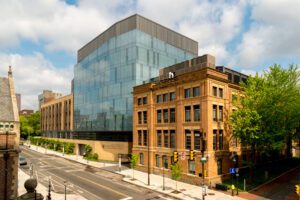
BioHealth Capital Region Eyes Continued Growth in 2023, Charts New Goals Amidst Tough Economic Headwinds
By Alex Keown
January 24, 2023
BioHealth Innovation’s lofty goal of the BioHealth Capital Region (BHCR) achievement of “Top 3 by 2023” is not likely to be reached this year due to inflation and uncertain economic conditions.
That’s the assessment of Rich Bendis, President and Chief Executive Officer of BHI, who has championed the region’s transition into a top four biopharma hub in the United States. However, given the state of the economy and the amount of money being invested, Bendis said it is unrealistic to expect the region to move up the ranking of the top 10 life sciences regions compiled by Genetic Engineering & Biotechnology News (GEN).
Bendis said the BioHealth Capital Region has all but two of the tools to become a top three hub, But, he said, what’s lacking are sizeable investments from venture capital and available jobs.

“We’ve exceeded many other areas identified by Genetic Engineering & Biotechnology News,” Bendis said, referring to the criteria used by that publication to create its GEN Top 10 Biopharma Clusters ranking. The ranking criteria include factors like funding from the National Institutes of Health, available wet lab space, and patent strength protecting intellectual property.
There have been shortages of available wet lab space across the country, but Bendis noted a more aggressive expansion of speculative wet lab space in the region. That’s something that will benefit the BHCR in the long run, he said.
The BioHealth Capital Region BHCR has held the fourth-place position in the GEN 10 ranks for the past several years. The top three spots are held by Boston, San Francisco, and the New York/ New Jersey areas. The BHCR was poised to move past New York/ New Jersey with increased venture capital funding and higher employment opportunities.
As 2022 came to a close, Bendis noted that the venture capital investments had fallen off. He also shared there was a slow-down in exits of companies from underneath VC umbrellas. He added that some regional companies also delayed fundraising during 2022 due to lower valuations.
“There’s no question there’s a lot of money sitting on the sidelines now,” Bendis said.
The question is when that money will be invested. Bendis predicted investments would occur in 2023, but how many and for how much remains to be seen. He suggested that investments made this year will be fewer and for larger amounts of money, primarily due to the time it takes per investment.
Beyond that, other global economic factors, including inflation and supply chain issues, have negatively impacted the potential for the BHCR to move into the number 3 spot, Bendis said.
“It’s going to take some time to recover from all of that,” Bendis said. “The more companies can bootstrap and take smaller rounds with less dilution, the better off they’ll be as we continue to recover in the investment and M&A climate.”
RELATED: These Non-traditional Life Science Funding Sources Can Help Beat Back the Bear Market Blues
While the region may not move into GEN’s third position spot in 2023, Bendis said it would be important to ensure the BHCR holds onto that fourth spot.
“There has been great growth across the region. We don’t want to fall back, and we want to maintain while we grow,” he said.
Looking at the region’s landscape, Bendis said one area that will likely see significant growth over the course of the year is cell and gene therapy development. He said there’s a growing cluster of cell and gene therapy companies in the region, which will provide drawing power for investments and workforce development opportunities. He also speculated that digital health could be a growth area in the region.
Biomanufacturing will also continue to play a key role in the region’s ecosystem. That could spur investments from companies like Kite, which has invested heavily in the region. Another company that could look to expand its manufacturing presence in the BHCR is Amgen, which recently acquired Horizon Therapeutics, a company that quadrupled its research and innovation space in Maryland last year.
Bendis said growth areas in the technology sector would likely center on artificial intelligence, machine learning, and quantum computing. As a result, those areas are likely to garner interest from investors, he said.
The entrepreneurial spirit remains strong in the BHCR, Bendis said. He pointed out the multiple entrepreneur-in-resident programs across the area, including those sponsored by the BHI. For example, Bendis said BioHealth Innovation has 18 entrepreneurs-in-residence that supports companies that receive funding from the National Institutes of Health. At George Mason University, a Life Science Mentor program was initiated to guide entrepreneurs in business development and help them prepare business models that can lead to potential success within the state’s ecosystem. In Montgomery County, an executive-in-residence program was established to further support economic development.
“I’m cautiously optimistic about 2023,” Bendis said.






